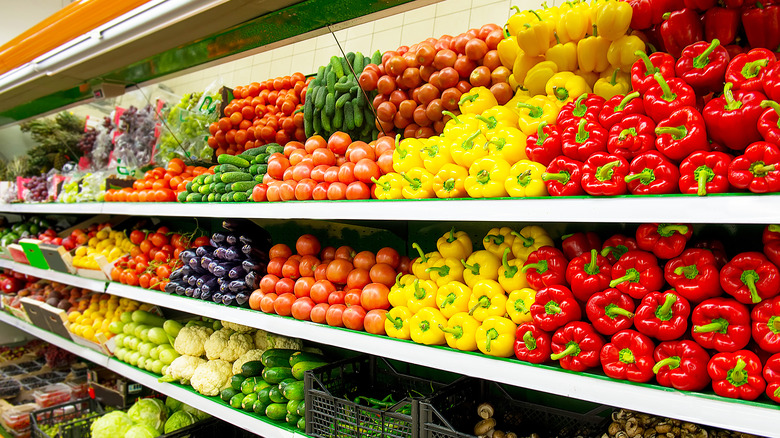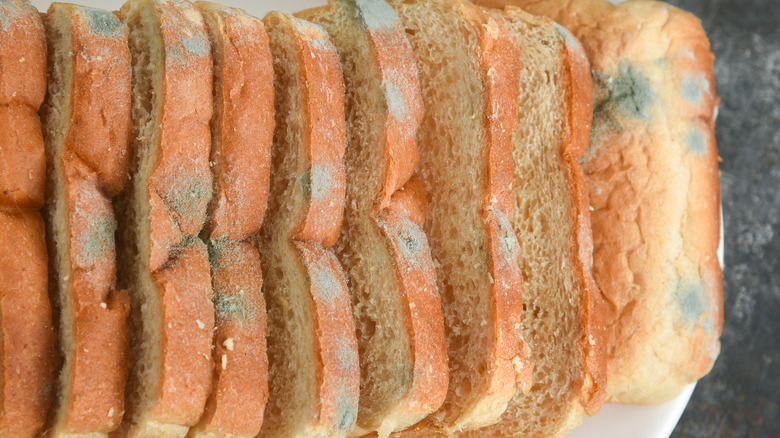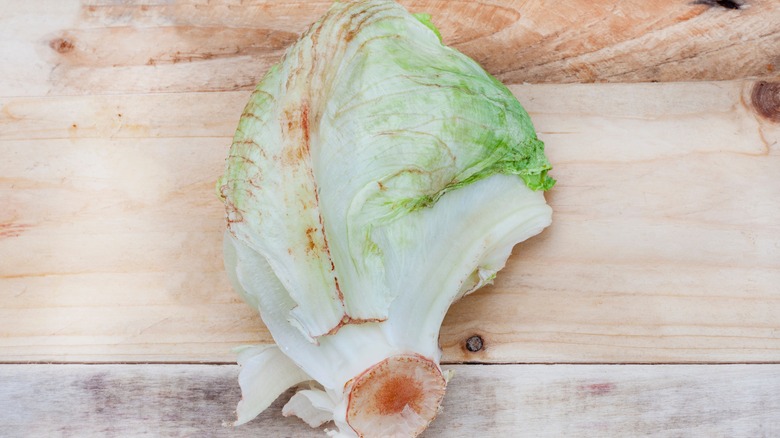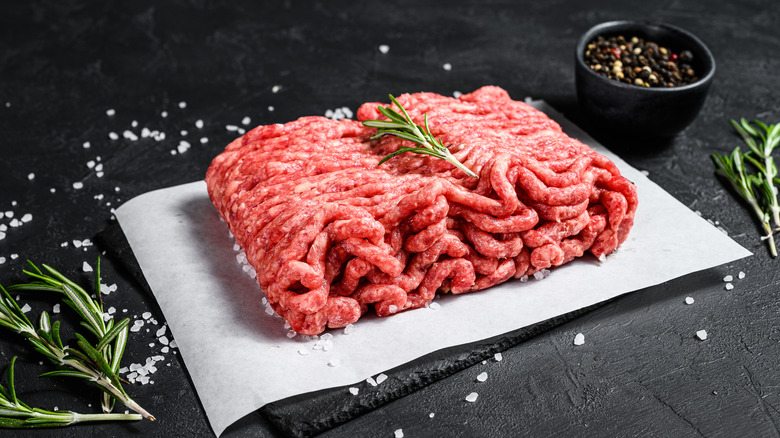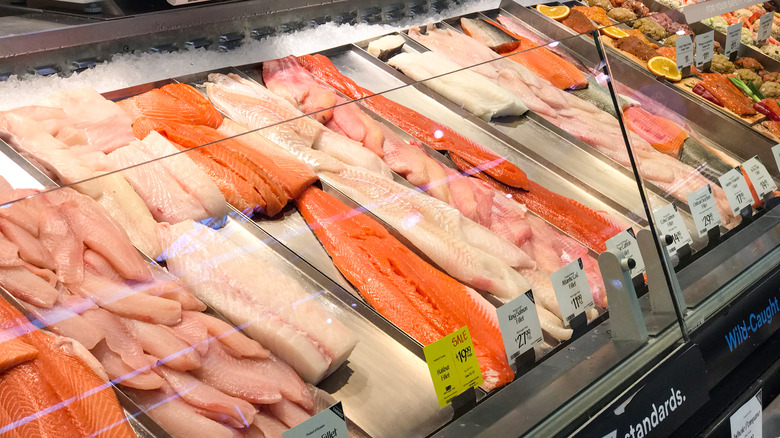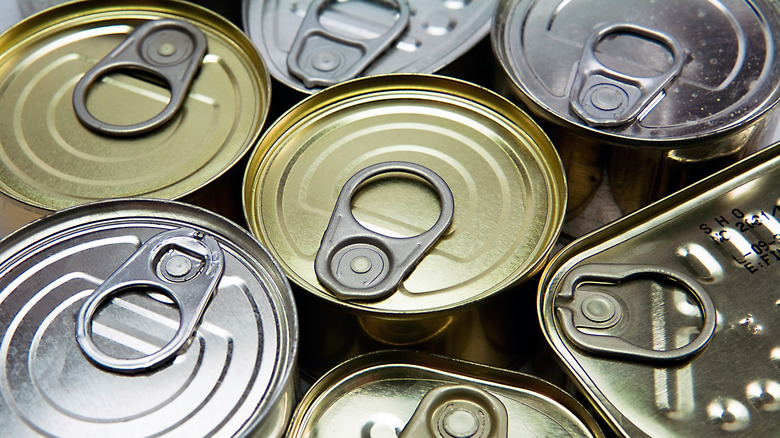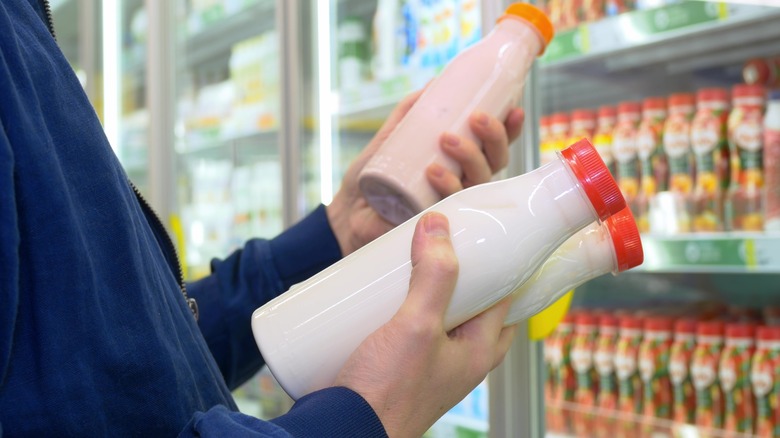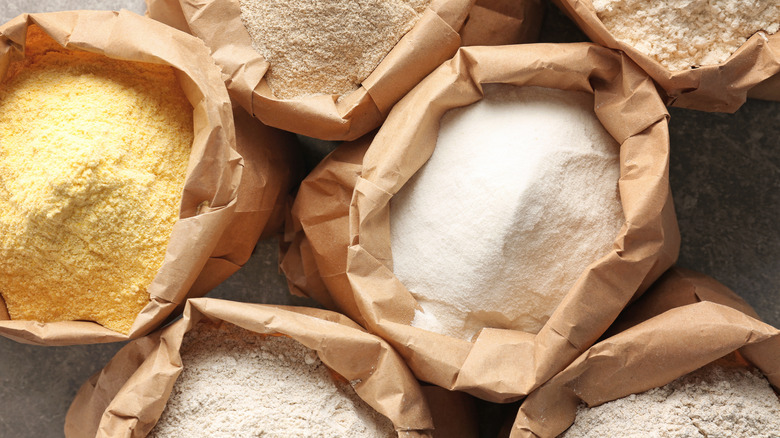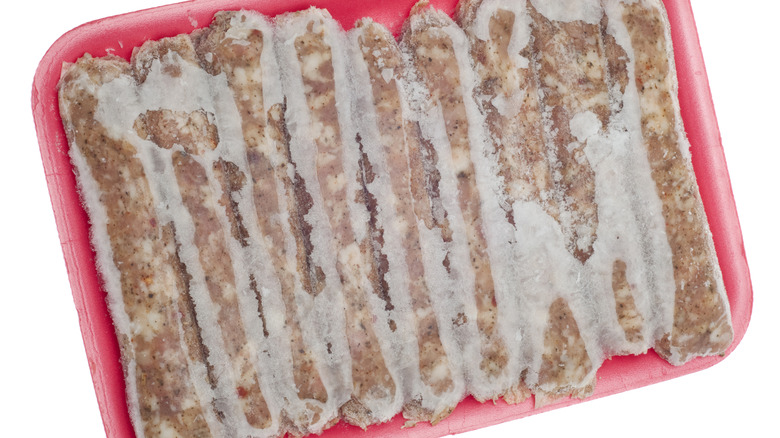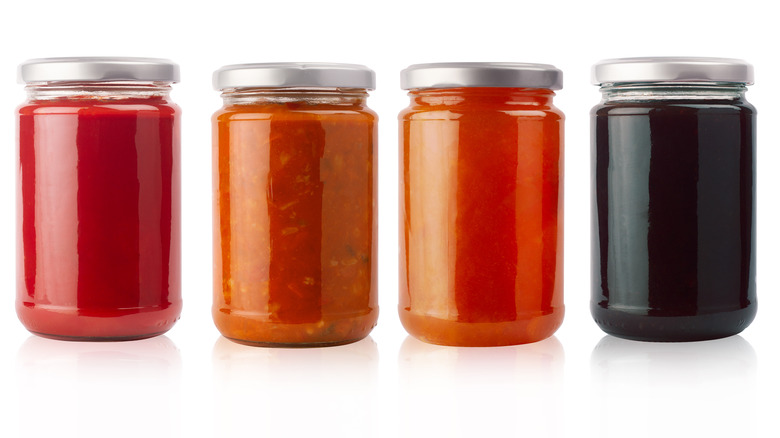12 Signs You Should Avoid Grocery Store Products Before Buying Them
With rising costs across the board, you might find yourself stretching your shopping budget as far as you can. The best way to save money is to shop smartly, and that doesn't always mean clipping coupons or scouting out the best deals. The best way to ensure that you're not throwing money directly into the trash is to keep an eye on the quality of the groceries you're purchasing.
There are plenty of red flags you can spot that indicate the items in your cart might not be at their peak, or might even make you sick if you were to eat them. With that in mind, a drop of prevention is worth a world of cure, especially if food poisoning is on the table.
It might seem a little extra to be so attentive, but if there's anything that you buy that deserves scrutiny, it's the food you eat and feed to your family. With that in mind, keep an eye out for these warning signs before you bring your items to the checkout.
Bread should be free from mold
We might find ourselves looking at the packaging and labels of the bread more than the state of the loaf itself. Give your bread a quick once-over through the wrapping. You shouldn't see any mold, green or white, or any dampness inside the plastic.
The issue with bread mold is how easily it spreads. Mold's little tendrils can easily spread through soft foods such as bread, and its spores can cause allergic reactions if inhaled. So you really don't want to be introducing mold unnecessarily into your home kitchen environment. Also, once mold has appeared, you can bet that other harmful bacteria have had to opportunity to flourish as well since they thrive in the same environment.
As counter-intuitive as it sounds, the bread will actually stay fresher in a breadbox or a loose paper bag once you get it home. Basically, you want to keep moisture away from your bread to prevent premature molding.
Check to make sure produce isn't wilted or slimy
This tip should seem pretty self-explanatory, but it's still important to keep in mind. When you're purchasing fruits and vegetables, especially leafy greens such as lettuce, spinach, or kale, you should give the veggies a thorough inspection. Most supermarkets employ a misting system to ensure that the greens stay hydrated until you get them home. However, if the produce has already started to go south, then there's not much that a little spritz of water will do. The leaves of your greens should be vibrant and should feel crisp. Rubbery or limp leaves mean that the veggies are dehydrated and won't last very long once you get them home.
When you're buying pre-bagged greens, give the bag a little shake and check to make sure there aren't any slimy clumps of leaves that have started to turn. Bagged baby spinach and arugula, for example, can start going bad before the bag is even opened, resulting in you having to trash the bag entirely. You can avoid wasting money by just being a little extra attentive when you make the initial purchase.
Meats should not be gray or green
Meat waste is a huge problem in American households. According to the USDA, American households throw away 27% of purchased meat without consuming it. That's a staggering amount of food waste when you consider how much resources meat production consumes. It's also going to reflect in your wallet if you find yourself pitching out uneaten meat week after week.
When you shop for meat, keep an eye out for signs of spoilage. The color of the meat is a dead giveaway for its freshness. Beef should be red or dark pink, pork should be pink, and chicken should be yellowy-white. You might notice the center of your ground beef or the underside of your steaks takes on a bit of a brownish tone after a day or so, but that's a natural reaction to a lack of oxygen. It should only be in places where the meat is not exposed to air. If the grey or brown areas are pervasive throughout the meat, it means that it is starting to turn.
If you are buying the steaks from a butcher case, don't be shy about asking to inspect the meat before they wrap it up for you. And give the package a quick sniff. There should be no sour or rancid odor given off by the meat.
Fish shouldn't give off an unpleasant odor
The same USDA study about meat waste also highlighted just how much fish and seafood gets tossed annually. Americans throw away a whopping 39% of purchased fish and seafood without consuming it.
It's not surprising that so much seafood goes to waste; it doesn't have as long a shelf life in the fridge as other foods. Fresh fish can typically be stored for two days in the fridge before it needs to be thrown out or frozen. With that in mind, you want to make sure that you are buying the freshest fish before bringing it home in order to get the most out of your purchase.
There are signs to keep an eye out for to ensure your fish is fresh. When you're at the fish case, take a breath in. You shouldn't smell any foul odors coming from the case itself. The most you should smell is a mild saltiness or fishiness, but nothing that instinctively makes you wrinkle your nose. The fish in the case should have vibrant flesh and not look slick or slimy. After your fish has been wrapped up, give it another quick sniff test. The fresher your fish is when you bring it home, the longer you have before you have to use it or freeze it.
Avoid bulging cans
It's understandable that a can of peaches might get slightly dented on its journey from the processing facility to the grocery store, and seeing some battle-scarred cans on the super-duper-discount rack at the store might be very tempting. While a ding or two on the outside of the can might be no big deal, you really want to make sure that the can isn't bulging.
Bloated or bulging cans indicate that the contents are releasing gases as they decompose, or that gas-creating bacteria have infiltrated the seal and are going to town on your green beans. In this case, it's always better to be safe than sorry. If your can is bulging, don't risk opening it. Just toss it.
As far as those discount-dented cans go, before you buy them, make sure you thoroughly inspect them — especially around the lid and seams. There shouldn't be any rust or leakage, and the lids should still be intact. The integrity of the can should still be solid, even if it's a little banged up. If you have any doubts, just skip them. Clostridium botulinum, the cause of botulism, is a nasty bacterium that can be lethal in even small amounts. Trust us, no cheap peaches are worth it.
Beware if dairy products feel warm
There's nothing worse than the unpleasant realization that your milk has gone sour after you've added it to your coffee or cereal. Dairy products have a limited shelf life as is, so you want to make sure that you're getting the most out of them when you make your initial purchase at the grocery store.
According to Clemson University College of Agriculture, milk should be kept at a consistent temperature below 40 degrees Fahrenheit. This inhibits the growth of bacteria in the milk and prolongs its shelf life. Any spike in that temperature range can cause the dairy to spoil faster, cutting days off its usability.
When you're reaching for the milk or yogurt, make sure that it feels cold. If it feels warm or room temperature, you might want to take your shopping elsewhere. You have no way of knowing how long it has been sitting at an improper temperature. If it is warm in the display case, there's a good chance that it wasn't properly maintained at the correct temperature in storage before it hit the shelves. Go for milk in the back of the case where it tends to be the coldest, and where it is less impacted by customers constantly opening and closing the doors of the refrigerator. Also, make it one of the last items that you add to your cart before checking out so that it is at room temperature for as little time as possible.
Make sure the packaging is intact and not torn or leaking
When you're buying packaged products like rice, flour, or cereal (really anything at all in a sealed container), make sure to inspect that packaging itself. There should not be any rips, tears, or leaks in the outer container. Damage to the box or carton could indicate that pests like insects or mice might have gotten to the contents. It also exposes the food within the packaging to spoilage and bacteria.
If you only notice that the packaging is damaged when you get home, give the contents a quick inspection. Check for any signs of bugs or spoilage. And always remember: When in doubt, just throw it out. Contaminants are not always visible to the naked eye, so you might just have to take the L and toss the goods if the damage looks like it might be at all indicative of a bigger issue with the food.
Frozen food shouldn't have ice crystals
Temperature consistency is a critical facet of food safety. All foods have a safe zone of temperatures that they shouldn't be out of for prolonged periods of time. Of course, there's a certain amount of trust that we place in grocery stores for maintaining that safe zone and an expectation that all the food we purchase has been kept at the correct temperatures before we make our purchases.
If you notice ice crystals have formed on your frozen food products, that's a red flag that the food has thawed and refrozen. While you might find this freezer burn on your food at home, it's not great to see it on products on store shelves. When your items at home have freezer burn, it could have come from the items thawing slightly on the drive home before they made it into the freezer. However, you have no way of knowing how long the items in the grocery store were at unsafe temperatures before they refroze on the shelves of the display freezer. While freezer burn itself isn't an issue, it's a warning sign that the food was improperly stored at some point during its shipment. You don't want to take the chance that it got to a point of contamination. So if you see ice crystals, keep them out of your cart.
Make sure the vacuum seal on jarred goods is intact
We know that struggling with a tight jar lid can be somewhat frustrating, especially when you get that intense pickle craving and you just moisturized your hands. But that vacuum-sealed pop that you hear when you first open the jar is incredibly important to keeping you safe.
During the canning process, jars are super-heated to kill bacteria. This creates a vacuum seal that is broken the first time you open the jar. Most, if not all, jars on supermarket shelves have an indented "button" in the center of the jar lid that pops up when you crack the vacuum seal. A lot of products go the extra mile and also provide a plastic collar or wrapping around the lid as well to further indicate that the seal has not been broken.
When you are selecting your jarred goods, give the lid a quick press. The button should not flex under your finger. The rim of the lid should also be free of dents or damage that might have broken the vacuum seal in shipping. While it might indicate malicious tampering, the bigger concern is that bacteria could have gotten into the contents of the jar and created spoilage. Much like with canned goods, botulism is a prime concern with jarred food that has had its seal compromised.
Peek inside egg cartons to make sure eggs are whole and clean
For most people, it's second nature to pop open the lid of the egg carton and double-check that all the shells are intact. If you're not one of those people, you might want to get into the habit. Not only is it a bummer to come home and realize that you're an egg or two short of a dozen, but you also want to ensure you're not inviting spoilage into your fridge environment.
The shells of the eggs should look clean and free from cracks. One of the biggest culprits of food-borne illnesses is salmonella, which is often found on the shell of the egg, not the inside, as is commonly believed. Typically, eggs are washed before they are packaged, reducing the chances of salmonella contamination. However, best practices still stipulate that you should bypass any eggs that look like they might have chicken droppings or dirt on them.
If you're buying hot, ready-made food, be aware of the temperature
Hot food bars, with their chicken wings and potato wedges, are like a siren's call at the grocery store. It's super tempting to want to grab a whole, baked chicken all hot and ready and say to heck with cooking dinner. And there's nothing wrong with that at all, provided that all the food is handled safely.
It's important that your grocery store be mindful of keeping its hot food bar up to food safety standards. It should appear clean and organized and free from cross-contamination. It also should be maintained at a temperature above 140 degrees Fahrenheit to prevent food from dropping into the temperature danger zone.
Food should be hot and steaming and not lukewarm or at room temperature. There should be a visible thermometer or an attendant making regular rounds to test the temperature of the foods that are out for consumption. Don't be shy about asking how often the food is replaced or when the food was put out. Most hot foods can only be kept under heat lamps for a couple of hours before they either become unsafe or unappetizing to eat.
Always check expiration dates
Of course, the number one thing that you should be doing when you do your shopping is checking the dates on all the goods you buy. Everything from canned goods to deli meat will have dates on them when they are "best by." Of course, this can be slightly misleading depending on how the food is labeled.
According to the USDA, a sell-by date indicates how long a store can stock the food item before it needs to be replaced for inventory purposes and has nothing to do with food safety. Similarly, a use-by date indicates the latest date it can be used to guarantee peak freshness and also doesn't have to do with food safety, just food quality.
So what does that mean for you, the consumer? In reality, it means that we might be pitching out a lot of food that isn't bad for us just because the date on the package has come and gone. But it certainly gives you an idea of the window in which the food should be used.
Static Media owns and operates Tasting Table and Mashed.
